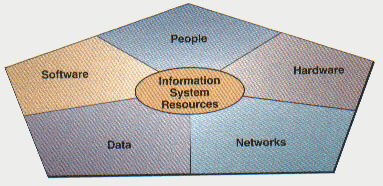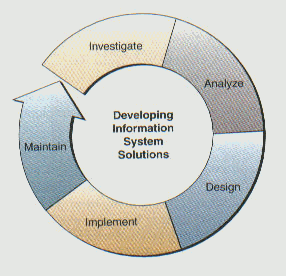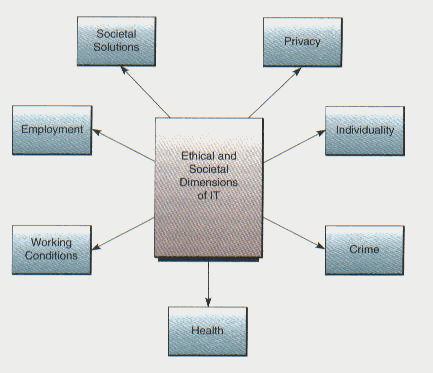
CSC 526
Information Technology in the Business Environment
Submitted in partial fulfillment
Of the requirements for the Degree
Of
Doctor of Philosophy, Computer Science
At
Central Pacific University,
Honolulu, Hawaii
By
Richard F. Kubli
Submitted to:
Anthony S. Russo, Ph.D, CS
Lead Computer Sciences Faculty Advisor

Central Pacific University
Contents
Introduction 3
Evolution of Information Technology (IT) Impact on Business 4
Fundamentals of IT 5
Business/IT Evolution 6
Hardware 7
Development Software 8
Network 9
Data Management 10
People 11
Development and Management Requirements 12
System Development Life Cycle (SDLC) Advances 14
Management of the IT Infrastructure 15
Enterprise-wide/Global Management Implications 17
Security and Ethical Challenges 18
The Future 21
Bibliography 22
Introduction
Information Technology (IT) since its inception in the early 1950's has become a vital component of the successful Business Enterprise. Initially IT supported the key general financial applications of General Ledger (G/L), Accounts Receivable (A/R), Accounts Payable (A/P), and Payroll (PR). IT or Data Processing ( DP as it was known in the early years) supported these early applications for a variety of Businesses. In fact the first commercial application was a punch card based system for the U.S. Bureau of the Census using the UNIVAC 1 (Universal Automatic Computer) in 1951. This initial IT application used the Hollerith 80 Column Punch Cards which became the foundation of many early IT or DP applications. 46 UNIVAC 1's were sold between 1951 and 1958 to support a variety of early Business Applications
One of my first jobs while in college in the middle 1960's was operating an Inventory System for a Wholesale Grocer that was based on these Punch Cards. The Punch Cards were our perpetual Inventory. When we pulled a physical case from the warehouse we pulled a card from the perpetual inventory Punch Card Data-store. My fraternity brother and myself sorted, collated, and listed the pulled cards. We changed the plug connections in the circuit boards that controlled the DP machines that sorted, collated, and listed the sales. Changing the plugs in the circuit boards was my first programming language. The Punched Card was our Database. We extracted information from the Punch Cards to produce Management Reports. In fact, from the listing runs I posted the sales to a manual Kardex. We did not perform manual handling of the Punch Cards ---We didn't have time --- We depended on these primitive machines to provide an accurate indication of weekly sales.
It is significant that Business Enterprises became dependent on IT for basic operational activities at even a very early stage. Today we are still dependent on IT for basic operational activities (i.e. counting ballots, clearing checks, and reporting sales), but more importantly we are now dependent on IT for tactical and strategic activities. Business Enterprises that utilize IT strategically are far more successful than those that view IT as merely an operational necessity.
Evolution of Information Technology (IT) Impact on Business
No longer is the Business dependent solely on IT to support basic operations. Successful Business Enterprises must marshal IT to support Tactical and Strategic activities to remain competitive and profitable. As such, everyone in the Business Enterprise must have a basic knowledge of how to apply IT to the Business Enterprise to ensure success.

Figure 1. --- Framework for Application of IT to the Business Enterprise
Today the entire Business Enterprise must understand how to apply Information Systems or IT to ensure the viability of the Enterprise. As such, a framework of understanding IT is critical for success. No longer is an understanding of IT confined to DP operational personnel as it was during my experience at the Wholesale Grocer. IT has become a "Second Language" that must be understood by all personnel within the Business Enterprise --- Clerks through the CEO.
The IT Framework that is critical to the Business Enterprise's viability includes five major disciplines of understanding: Foundation Concepts; Business Applications; Management Challenges; Information Technologies; and Development Processes. Regardless of the evolution of IT, the Framework satisfies the understanding requirement.
Likewise as the Framework is adapted to the progressive improvement of IT over time, so is the essential IT resources that are required by the Business Enterprise. Even at the Wholesale Grocer we still depended on People, Software, Hardware, Data, and Networks. No doubt these IT resources have become technologically more sophisticated as IT has evolved to become a greater and essential facilitator of Business Processes --- But the basic IT Fundamentals remain unchanged.

Figure 2. --- Information System (IT) Resources
Although this is the traditional view of IT, it must be associated with the IT Framework view to ensure the Business Enterprise has the knowledge to properly apply IT to the Business Enterprise. The IT Framework view requires the Business Enterprise to view IT as a Strategy critical for supporting it's Business Strategy. As such, the Business Enterprise has created a Knowledge Based Process that will allow it to keep pace with the rapid IT revolution and apply it to ensuring the viability of the Business Enterprise.
Business/IT Evolution
The core IT resources have improved dramatically in terms of cost and technological advancement. With the exception of People, the price/performance ratio of the IT Resources has improved dramatically. Moreover, the application of IT Resources to support the Business Enterprise's operational, tactical, and strategic processes has expanded exponentially.
Hardware

Figure 3. ---- Major Trends in Hardware Capabilities
Major gains in technology and price/performance have been achieved as the IT industry progressed from First Generation to Fifth Generation Hardware. These gains have been applied to the Business Enterprise in the form of Applications never imagined in 1951 with the UNIVAC 1.
Development Software

Figure 4. --- Major Trends in Development Software Capabilities
Likewise we see comparable advances in Development Software. Development Software provides the key to reap the great largess provided by the advances in Hardware. Moreover, Development Software provides the "building blocks" or components to construct Applications far more complex and sophisticated than those that I used at the Wholesale Grocer (i.e. First Generation).
Furthermore, Development Software is the glue that binds the IT Resources together to form a common vehicle for supporting the Business Enterprise's operational, tactical, and strategic activities and initiatives. The success of Microsoft is a testimonial to this assertion given the success of the WINTEL Platform.
Network

Figure 5. --- The Connected Business Enterprise
The Business Enterprise in the new millennium must be connected to remain viable. As Development Software provides the glue to bind the IT Resources, the Network is the glue required to connect the IT Infrastructure. Business Enterprises can no longer remain "Location Dependent". Consequently, the Network Resource must provide virtual connections using universally accepted mechanisms to connect Business Partners, Customers, Suppliers, Remote Offices, Headquarters, and etc.
The Network Resource is critical to ensure the Business Enterprise achieve its operating, tactical, and strategic Business Goals. If the Network is compromised or fails to perform, the Business Enterprise ceases to function. The IT Infrastructure no matter how proficient the individual components of that Infrastructure function will fail if the Network fails to perform.
Data
Management
Figure 6. --- Web-based Data Management
The Network Resource provides the means to connect the major components of the IT Infrastructure. Business Enterprise-Wide information must be made available (i.e. Given Security Restrictions) to everyone having access to the Network. If Enterprise-Wide Data is not accessible it cannot be transformed into Information.
Furthermore, an Enterprise-Wide Data Model must be developed to normalize the vast amount of Data residing within the Business Enterprise. Unless the Data Model is developed, deployed, and maintained, the Business Enterprise will find itself "Data Rich" but "Information Poor".
I have personally extended older Legacy Systems to a Web-based Three Tier Model similar to that depicted in Figure 6. In cases were the Data Model was not developed for the Host Tier, the full benefits derived by providing Web Browser universal access cannot be achieved. Even though the physical connectivity is provided, the logical access algorithms (i.e. Keys to the Data) preclude the desired access to the Data --- Thus "Data Rich" but "Information Poor".
People

Figure 7. --- Virtual Multi-Disciplinary Enterprise Teams
The most important IT Resource, as always been the case, is People. The initial premise proposed earlier is that the Business Enterprise requires a Framework for the Application of IT to the Business Enterprise (Figure 1.) that is understood, accepted, and executed by all the People within the Enterprise. No longer do People within the Business Enterprise apply IT exclusively to support basic operational activities. The application of IT has evolved to include tactical and strategic activities as well. As such, everyone in the Business Enterprise from Executives to Clerks must contribute to the People IT Resource.
Utilization of the IT Infrastructure provided by the Hardware, Software, Data, and Network IT Resources (Figure 2.) allow for virtual multi-disciplinary teams to collaborate on projects directed at applying IT to the Business Enterprise. Thus the People Resource aided by the evolutionary improvements in IT becomes more cost-effective in providing an improved quality of Applications servicing the Business Enterprise.
Development and Management Requirements
Given the Business/IT Evolution has been revolutionary since 1951, the requirements to develop and manage these complex and sophisticated applications of IT have established a new set of challenges. These challenges can best be met by utilizing the very advances in IT that have evolved since 1951. People within the Business Enterprise can best address these development and management requirements by taking advantage of emerging IT as it becomes available.

Figure 8. --- IT Change Management Model
Managing IT has become a dynamic process directed at utilizing IT itself to effectively coordinate a diverse group of multi-disciplinary teams toward a common purpose. People focused toward improving, enhancing, and re-engineering the Business Enterprise's Business Processes through the proper application of IT are the key to ensuring successful management of the IT Function.
System Development Life Cycle (SDLC) Advances

Figure 9 --- The Cyclical Systems Development Life Cycle (SDLC)
In the beginning (1951) the SDLC was a straight-line discrete process. Once the System was implemented the SDLC was completed. The completed System was then accepted by the Business Enterprise and maintained until it became functionally obsolete. The typical System after implementation had an estimated 5 year life span until obsolescence and replacement.
In practice, however, we still have many Legacy Systems that are 20 and 30 years old that have never been retired or re-architected. As such, the SDLC has evolved from the straight-line discrete process to a cyclical continuous process where the maintenance phase recycles into the investigation phase. This approach allows advances in IT to be rapidly applied to the enhancement, extension, and restructuring of the System thus extending it's life on a continuous basis.
Management of the IT Infrastructure

Figure 10. --- Managing Information Technology (IT)
Managing the IT Infrastructure has stressed the People Resource, do to the rapid and unprecedented advances in IT. IT is no longer DP. It's hard to imagine how far we have come since 1951 and/or my days at the Wholesale Grocer in the middle 1960s. The rate of change has not only been rapid, but has been a progressively rapid. IT Developments along with IT's ever increasing impact on Business Enterprise Pressures have exacerbated the demand for IT Professionals with the experience, fortitude, and vision to manage the IT Infrastructure.
IT Managers must not only understand IT, but more importantly, how to apply IT to support the Business Enterprise's Business Plan. As such their stature has been elevated to that of other Professional Managers coming from the Legal, Accounting, Finance, and Management Professions. They now serve on Boards of Corporations, chair Executive Committees, and drive Business Acquisitions. Today IT Managers hold positions such as: Vice President (VP); Chief Information Officer (CIO); Chief Technology Officer (CTO); and Chief Information Strategist (CIS).

Figure 11. --- Information Resource Management (IRM) Concept
Management of the IT Infrastructure has evolved from managing a single discipline to managing multiple disciplines. No longer is IT confined to managing circuit boards and unit record punch card handling machines. Today the IT Infrastructure has become a Business Entity itself. As such the IT Manager has evolved from a DP Manager to a multi-faceted Business Enterprise Manager.
Enterprise-Wide/Global Management Implications

Figure 12. --- Process View of IT Management
Today's Process View of IT Management extends throughout the entire World. No longer is the Business Enterprise confined to s single Country. As such the Process managed is global, requiring the IT Infrastructure traverse traditional physical, cultural, and political boundaries. This expanded universe has put additional strain on IT Managers to accommodate a wide range of Global IT Standards and Practices.
As such, the People Resource becomes a more complex and challenging task to manage. I recently was on a consulting assignment in Puerto Rico managing a project to extend and enhance a Legacy Customer Order System for the Puerto Rico Telephone Company that had just been acquired by GTE. The Project Team consisted of individuals from Puerto Rico, GTE-Dallas, US, and India. Given the language, cultural, political, and IT background differences, special attention was required to ensure everyone was on "the same page". It is truly a "Global Society". Accordingly, IT Management must address and be prepared to deal with this inevitable reality.
Security and Ethical Challenges

Figure 13. --- Public Key/Private Key Encryption Model
The IT Systems of today are far more complex than the mundane Systems first introduced in 1951. The E-Commerce Systems of today and the future require that special attention is paid to Security as the Punch Card transactions of the past have been replaced by electronic messages that traverse public networks using Internet Technologies to reach their processing destination. Encryption techniques are required to ensure the integrity and privacy of these messages. As such, all new Systems must incorporate appropriate Security and Controls to ensure the integrity of the System. Addressing Security Issues thus becomes an important aspect of all phases of the SDLC.

Figure 14. --- Internet and Intranet Fire Wall Example
In addition to designing Security specific to each System, Security must be incorporated into the IT Infrastructure as part of the Network Architecture. Firewalls must be constructed and monitored to protect the Business Enterprise from the outside world. Private Networks must be protected from Public Networks. Private Networks must also protect themselves from access by unauthorized Users from within the Business Enterprise.

Figure 15. --- Ethical and Societal Aspects of IT
Although Security has become a major issue in the SDLC and Management of IT, it can never become 100% perfect. As such, to compliment the Security System, attention should be paid to Ethical and Societal Issues --- particularly when managing IT in a Global Society.
The best way to optimize Security throughout the Business Enterprise is to make all Employees and Business Partners "Security Cops". This requires that all parties share the same Standard of Ethics.
The Future
An almost exponential advancement in the application of IT to the Business Enterprise has occurred since the inception of those primitive Commercial Applications that originated in 1951 with the introduction of the UNIVAC 1. Ordinarily it is expected that this trend will continue as the Hardware, Software, Network, and Data Management Resources also continue to advance at an exponential rate. However, the IT Resource that impacts this "rosy" scenario to the greatest degree is People.
As such, the People Resource will determine, in the end, the success or failure of applying IT to the Business Enterprise. This will depend upon how the Business Enterprise views and applies IT. If IT is viewed as merely an operational necessity and ignores it's impact on the tactical and strategic processes that drive the Business Enterprise , then I predict failure. On the other hand, if IT is viewed as a Strategic Resource, then I predict success.
As such, it all depends upon how the People Resource is utilized by the Business Enterprise.
Bibliography
1.) Introduction to Information Systems, Essentials for the Internetworked Enterprise, 9th Edition, James O'Brien, Irwin-McGraw-Hill Publishing, 2000
2.) Encyclopedia of Computer Science, Anthony Ralston, Petrocelli/Charter, 1976
3.) Automatic Data Processing, The Diebold Group, McGraw-Hill, 1977
4.) The Waves of Change, A Techno-Economic Analysis of the Data Processing Industry, Charles P. Lecht, Advanced Computer Techniques Corporation, 1977
5.) Handbook of Successful Data Processing Applications, Jerome K. Pescow, Prentice-Hall, 1973
6.) Standard Dictionary of Computers and Information Processing, Martin H. Weik, Hayden, 1969
7.) Data Communications Dictionary, Charles J. Sippl, Van Nostrand Reinhold, 1976
8.) Dictionary of new Information Technology, A.J. Meadows, Nichols Publishing, 1982
9.) Simplifying LAN-WAN Integration, Wellfleet Communications, Inc., 1993
10.) Computer Networks and Distributed Processing, James Martin, Prentice-Hall, 1981
11.) Future Developments in Telecommunications, James Martin, Prentice-Hall, 1977
12.) Ethical Decision Making and Information Technology, Ernest A. Kallman, McGraw-Hill, 1996